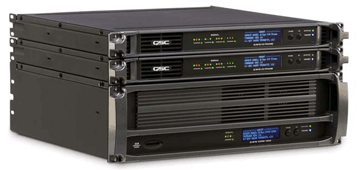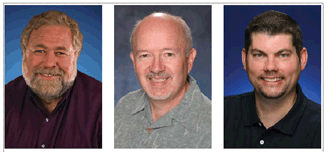QSC Launches Its Q-Sys Processing And Control System
Working for almost three years on what promises to be a significant product development, QSC will use InfoComm 09 as the official launch for Q-Sys, its new processing and control system. Combining digital signal processing and routing with complete system monitoring and control, this next generation of DSP technology was developed by two teams—one based at QSC corporate headquarters in Costa Mesa, CA, and another in Boulder, CO. At the latter location, the talents of Rich Zwiebel were enlisted, as well as those of many of the engineers who worked hand-in-hand with him high in the Rockies to create industry-standard technologies like CobraNet and MediaMatrix.
“We’ve been quietly working away on a family of new products that really changes the way things are done in high-end systems,” said Zwiebel, who now wears the title of VP of systems strategy at QSC. “We wanted to have one unified GUI that lets you do everything, that really goes beyond what already exists in the industry.”

QSC will use InfoComm 09 as the official launch for Q-Sys, its new processing and control system. making the decision not to build on existing product platforms, although in anticipation of retrofits in installations with legacy gear, Q-Sys was made compatible with all QSC dataport amplifiers. In outlining the four principal priorities in creating QSys, Zwiebel cites reliability, ease-ofuse, powerful processing, and, of course, a product “that sounds great.”
QSC’s hardware and software testing ensures reliability, but Q-Sys was also built to run in a fully redundant manner that includes a system’s processing, inputs, outputs, and the network. “So if anything in the system fails, it very quickly and automatically switches over,” Zwiebel explained. “You don’t have to worry about a failure. In fact, you could have your I/O frame, your central processor, or your network break, and you’ll still keep running.”
The ease-of-use factor was addressed in the creation of Q-Sys Designer software, which may be used online or offline, and is extremely intuitive with an integrated help system that provides assistance when and where it’s needed. Components may be easily scaled on the fly in terms of channel count, frequency bands, or other parameters.
“There are a lot of little details in the software,” Zwiebel pointed out. “For instance, making it easy to graphically align components keeps the system designer focused on the design solution rather than on how to run the software.”
In terms of getting components on the network talking to one another, QSC VP of Marketing Gerry Tschetter noted that “With the architecture we use and the way we’ve done this system’s software, you really don’t have to think much at all about network audio assignments.”
Q-Sys’ centralized processing offers many benefits, with a compile time of mere seconds instead of the minutes often endured when making system changes. “There’s one box with all the processing,” Zwiebel emphasized. “If you want redundancies you just load them in. The software does it all-speaker supervision, amplifier monitoring, and control—it’s all part of the package, not separate. We’ve also integrated test and measurement functions in the form of FFT-based measurement for impulse response and spectrum analysis.”
QSC additionally wanted to extend the overall system functionality beyond the digital processing boxes themselves, Tschetter added, “So we’ve come up with some of the nicest, smoothest methods of pulling the amplifiers into the system and design GUI, making them an integral part rather than something that hangs off of the DSP and maybe operates on its own different network with a different user interface. We are even integrating loudspeakers more tightly into the DSP system with more than just an ability to go to a menu and recall presets.”
In order to perform these many tasks, Q-Sys had to be powerful: “Every DSP product has some kind of limitation within its processors,” Zwiebel said. “We wanted to make it so you didn’t have to think so much about the processing, just add up your I’s and O’s.”
The Q-Sys Core is the engine of the system, with processing capacity “so great, it is unlikely any realworld design will use all of it,” Tschetter related. Although I/O capacity will vary depending upon system design, the Core 1000 offers the capacity for 64 inputs x 64 outputs, the Core 3000 provides the capacity for 128 inputs x 128 outputs, and the Q-Sys Core 5000 features up to 512 inputs x 512 outputs.
To provide a framework for the power held by the Core components, Tschetter came up with a DSP-driven pun: “It’s basically like a small sea of Sharcs.” Zwiebel elaborated: “The 1000 is equal in processing power to 15 300 MHz Sharc chips, the 3000 is equal to 30. The 5000—we really don’t know the number yet, we’re still working on it. But it’s much larger.”

Members of QSC’s Q-Sys development team (from left): Rich Zwiebel, Gerry Tschetter, and Dale Sandberg. of audio. Using AES cards can deliver up to 32 channels of audio. Four slots may be fitted with a range of audio input and output cards. Q-Sys I/O Frames may be located in the same rack as the Core, or at any location in a facility that can be reached by ethernet.
All Q-Sys products are connected via a standard Gigabit ethernet network. “The network will carry 512 bidirectional channels,” Zwiebel reported. “Our latency from analog input to analog output, including network delay, D to A, processing, and A to D, is 2.5 milliseconds.”
Q-Sys beta installations began in late March, and the new system will be demonstrated at InfoComm, with training to begin immediately after the show. Initial reactions to Zwiebel’s field demonstrations of Q-Sys have been positive. “A lot of times when you come up with a new product in this category, you have a lot of skepticism,” Tschetter observed. “But with Q-Sys we’re getting people who are saying ‘get me one, I need it now’.”
Already, dealer feedback has produced ideas for peripherals and additional software functionality. “Launching the product is just the start,” Tschetter added. “The capabilities of the system are going to expand considerably as time goes by.”